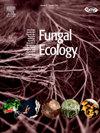疏雨对北方森林景观土壤真菌的影响
IF 2.2
3区 环境科学与生态学
Q3 ECOLOGY
引用次数: 0
摘要
由于气候变化,干旱日益频繁和严重。然而,它们对北方森林真菌群落的影响尚不清楚,特别是不同真菌功能和分类类群之间的影响。我们在瑞典北部森林景观的25个地点采用1 × 1 m处理和对照地块的配对设计,诱导了45个夏季降雨排除试验。试验结束后,我们立即评估了对土壤真菌生物量、群落组成和2个月后孢子产量的影响。拒雨对土壤真菌生物量影响不显著,但真菌群落组成受到影响。在防雨样地,外生菌根和腐养担子菌的丰富度降低,子囊菌的丰富度不受影响。腐生菌根真菌和外生菌根真菌的孢子囊产量均减少。我们的研究表明,小规模降雨排除的明显影响表明,北方森林的地下真菌群落可能容易受到干旱的影响。本文章由计算机程序翻译,如有差异,请以英文原文为准。
Effects of rainfall exclusion on soil fungi in a boreal forest landscape
Due to climate change, droughts are increasingly frequent and intense. Yet, their impact on boreal forest fungal communities remains unclear, especially across different fungal functional and taxonomic groups. We induced an experimental rainfall exclusion for 45 summer days, using a paired design of 1 × 1 m treatment and control plots replicated in 25 sites in a boreal forest landscape in Sweden. Immediately after the experiment, we assessed the effects on soil fungal biomass, community composition and, after 2 months, sporocarp production. We did not detect significant effects of the rainfall exclusion on soil fungal biomass, but the fungal community composition was affected. In the rainfall exclusion plots, richness of ectomycorrhizal species with extensive extramatrical mycelia and saprotrophic basidiomycetes was reduced, while richness of ascomycetes was not affected. Sporocarp production of both saprotrophic and ectomycorrhizal fungi was reduced. The clear effects of a small-scale rainfall exclusion demonstrated in our study suggest that belowground fungal communities in boreal forests may be vulnerable to drought.
求助全文
通过发布文献求助,成功后即可免费获取论文全文。
去求助
来源期刊

Fungal Ecology
环境科学-生态学
CiteScore
5.80
自引率
3.40%
发文量
51
审稿时长
3 months
期刊介绍:
Fungal Ecology publishes investigations into all aspects of fungal ecology, including the following (not exclusive): population dynamics; adaptation; evolution; role in ecosystem functioning, nutrient cycling, decomposition, carbon allocation; ecophysiology; intra- and inter-specific mycelial interactions, fungus-plant (pathogens, mycorrhizas, lichens, endophytes), fungus-invertebrate and fungus-microbe interaction; genomics and (evolutionary) genetics; conservation and biodiversity; remote sensing; bioremediation and biodegradation; quantitative and computational aspects - modelling, indicators, complexity, informatics. The usual prerequisites for publication will be originality, clarity, and significance as relevant to a better understanding of the ecology of fungi.
 求助内容:
求助内容: 应助结果提醒方式:
应助结果提醒方式:


